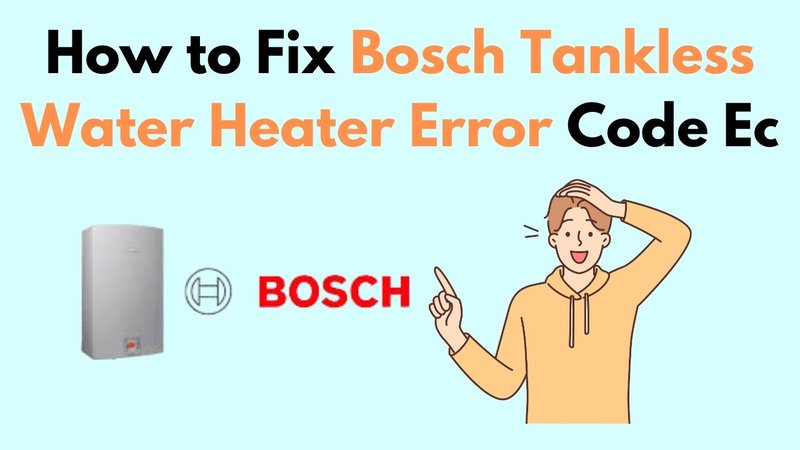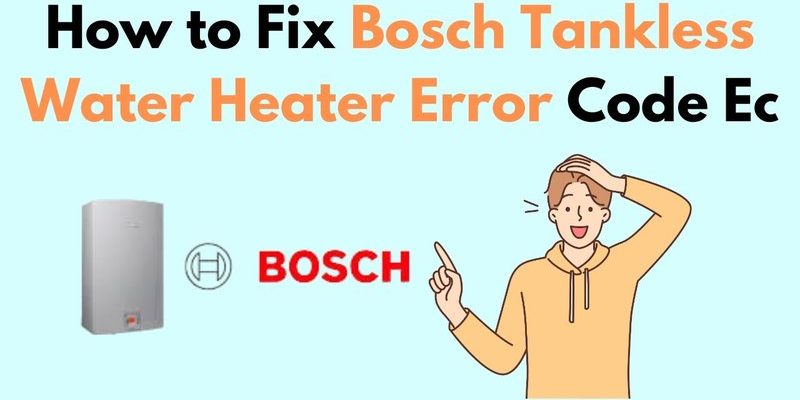
Error codes on appliances can feel like cryptic messages. In the case of your Bosch water heater, the “LE” error code indicates a problem related to the water inlet valve or the unit receiving insufficient water flow. It’s kind of like when your garden hose has a kink, and no water comes out. Fortunately, with a bit of know-how and some preventive measures, you can avoid this issue and keep your water heater running smoothly.
Understanding the LE Error Code
Before diving into prevention, let’s first grasp what the “LE” error code is trying to tell us. When your Bosch water heater flashes this code, it’s essentially raising its hand to say, “Hey, I’m not getting enough water, and it could lead to bigger problems if ignored.” Think of it as your heater’s way of avoiding burnout.
This code can often be traced back to a problem with water flow. Imagine your water heater as a team player in a football game. If the water, like a team member, isn’t playing its role properly, the whole team (your water heater) can’t function effectively. A clogged or faulty inlet valve can restrict water flow, leading to the error code. Sometimes, mineral build-up in the pipes acts like a blockage in a straw, keeping water from flowing freely.
What’s important here is that an LE error isn’t just a nuisance. If left unaddressed, it could mean no hot water, reduced efficiency, or even damage over time. So, it’s essential to pay attention and take steps to prevent it from reoccurring.
Causes of the LE Error Code
Now, let’s look at what might cause an LE error. You’re dealing mainly with a water flow issue, so think in terms of blockages and supply problems. First, mineral deposits are a common culprit. Much like a drain getting clogged with hair or debris, the inlet valve in your water heater can accumulate minerals over time, especially if you live in an area with hard water.
Another potential cause is a faulty inlet valve. If the valve is malfunctioning, it could be compared to a broken gate that won’t open properly, preventing water from entering the heater. This is less common but still worth checking out.
Lastly, consider the possibility of more significant plumbing issues. Sometimes the problem could stem from blocked pipes or low water pressure in your home. It’s like expecting a consistent stream of water from a fountain, but only getting a trickle—frustrating and inefficient.
Steps to Prevent the LE Error Code
Alright, so how do you prevent this from happening again? The key lies in regular maintenance and a bit of proactive care. First, think about regularly checking and cleaning your water inlet valve. It’s like giving your car an oil change—necessary to keep things running smoothly. Simply remove any build-up or debris that might be restricting water flow.
You can also consider installing a water softener if hard water is an issue in your area. By reducing mineral deposits, you’re essentially removing the obstacles in the water’s path to the heater, much like clearing snow off your driveway to ensure a smooth ride.
Another practical step is to routinely check your water pressure. Make sure the pressure is within the recommended range for your Bosch water heater. You don’t want it too high or too low, as either could lead to operational issues.
Maintaining Your Bosch Water Heater
Regular maintenance is your secret weapon in keeping the LE error code at bay. But what does maintaining your water heater entail? It’s simpler than you might think. Start by scheduling a periodic inspection with a professional. Think of it like visiting the doctor for a regular health check-up — it can help catch small issues before they become big headaches.
Aside from professional checks, you can perform some upkeep yourself. Flush the system every few months to clear out sediment. It’s like cleaning your gutters; if you let it build up, it can cause water backup and overflow. Furthermore, inspect the inlet valve every so often to ensure it’s free of obstructions, and replace it if it appears worn out.
Lastly, stay informed about your unit by reading the manual. Knowing how your specific Bosch model functions can empower you to handle minor problems or spot bigger ones early. It’s akin to having a map when navigating unknown territory — it takes away the guesswork.
When to Call a Professional
Even with the best DIY efforts, there are times you’ll need to bring in the pros. But how do you know when it’s time? If you’ve tried the basic troubleshooting steps—like cleaning the inlet valve or checking your pipes—and the LE code persists, it’s probably a sign to call a technician.
A professional will have the tools and knowledge to identify and repair problems you might not be equipped to handle. It’s like trying to fix a complicated wiring issue in your house; sometimes it’s safer and more efficient to let the electrician handle it.
Moreover, if the error persists and your water heater is still under warranty, a technician’s services might be covered. So, ensure you’re not voiding any warranty by attempting repairs that should be handled by certified professionals.
Final Thoughts
Preventing the Bosch Water Heater Error Code LE isn’t complicated, but it does require diligence and a little detective work. By understanding the causes and implementing regular maintenance, you can keep your water heater—and those cozy showers—running without a hitch. Remember, a bit of prevention goes a long way in ensuring your water heater stays in top shape, so you can enjoy the comfort of a nice, warm shower whenever you wish.
